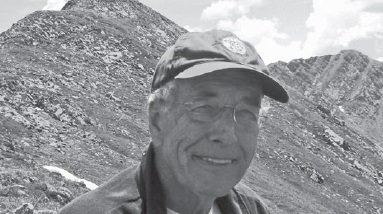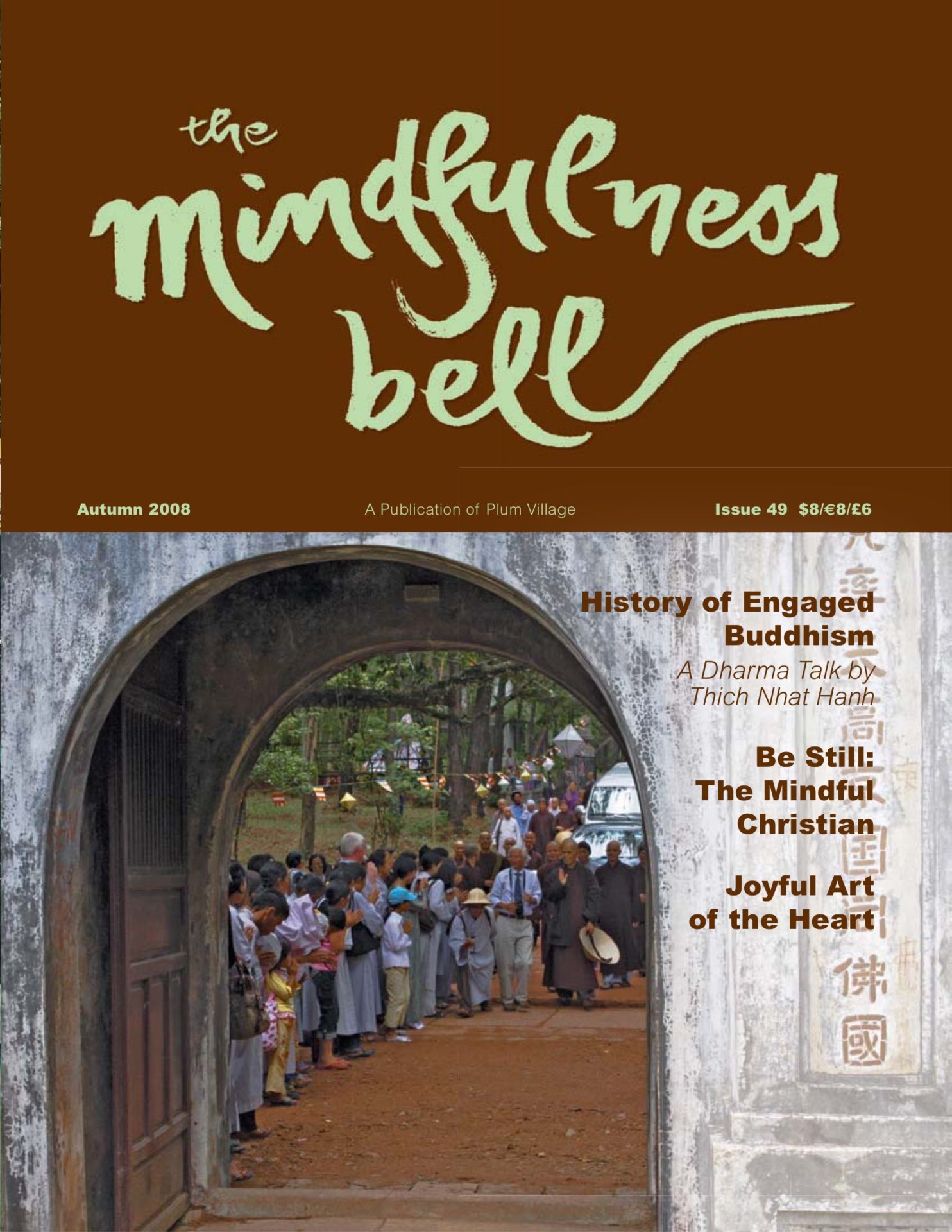
By Larry Calloway
Thich Nhat Hanh’s return to Vietnam in May for several retreats followed by a United Nations conference was a triumph for his “engaged Buddhism.” Not only was his global influence evident at the conference, but he and four hundred retreat participants (most of us Westerners) were warmly received on a dramatic slow walk in the center of Hanoi.
Triumph perhaps is too military a term for the vindication of an eighty-two-year-old monk who teaches “peace is every step,” but his young life was defined by war,

By Larry Calloway
Thich Nhat Hanh’s return to Vietnam in May for several retreats followed by a United Nations conference was a triumph for his “engaged Buddhism.” Not only was his global influence evident at the conference, but he and four hundred retreat participants (most of us Westerners) were warmly received on a dramatic slow walk in the center of Hanoi.
Triumph perhaps is too military a term for the vindication of an eighty-two-year-old monk who teaches “peace is every step,” but his young life was defined by war, as was his ancient nation. Not until 2005 was he free to return after thirty-nine years — exiled first by the anti-communists, then by the communists.
Sponsoring this year’s UN Vesak Conference was a significant move for the Socialist Republic of Vietnam, which has been criticized for religious repression but is encouraging tourism and the recovery of ancient cultural traditions. The conference at Hanoi’s proud new National Convention Center included formal workshops on a variety of issues addressed by Thich Nhat Hanh and his monastic representatives. But because the world continues to suffer from “the scourge of war,” and perhaps because the conference was for the first time in Vietnam, the issues of war, conflict, and healing were foremost.
In his opening address, Phra Dharmakosajarn, one of the most prominent monks in Thailand, made the connection between world peace and Buddhism saying, “No doubt meditation and moral principles contribute to peace, since war begins in the minds of men.” Or, as Thich Nhat Hanh put it in his keynote address, “The roots of war and conflict are in us!”
Thay proposed “the idea of engagement,” he told us, in his first published article in 1954. It was “a time of great confusion” in Vietnam. (The French colonialists, defeated at Dien Bien Phu, were exiting and the Americans, covert sponsors of the Ngo Dinh Diem regime, were entering.) As war formed in the minds of McNamara, Rusk, Bundy, the joint chiefs, the Kremlin, Mao, and others, the Vietnam Buddhists countered, in so many words: Leave Vietnam alone!
Perhaps because this was Vietnam, Thay’s Dharma talks in the eight-day retreat dwelt on the American war, as it is known there. The people of the small nation were
caught between foreign ideologies. “Everyone was willing to die for ideologies,” he said, but Buddhism teaches freedom from ideology. The fighting was with ideas and weapons from the outside. “How can you fight such a war? Brother against brother?”
In the early sixties Thay went often to the United States, where he would eventually study at Princeton, lecture at Cornell and teach at Columbia. He was a powerful multilingual anti-war speaker. But sometimes there was a problem. At a huge anti-war rally in 1966 a young man suddenly yelled, “Why are you here? You should be in Vietnam fighting the American imperialists!” In other words, Thay said, the man wanted him to fight, to kill Americans. He answered, “Well, I thought the root of the war was here — in Washington — and that’s why I have come.”
No Ordinary Protester
In Hanoi I met Paul Davis, who had a similar thought at an anti-war march in New York in the sixties. People started yelling, “Ho Chi Minh, Ho Chi Minh, you’re the one who’s gonna win.” That was never the point.
Paul was no ordinary protester. He had joined the United States Marines two weeks after his high school graduation in rural Ohio and landed at Da Nang in 1965, when the U.S. under President Johnson began direct combat operations. Davis was wounded in 1966, and while recovering in the U.S. appeared as a Marine on a panel at a college. Someone asked him if the Vietnamese wanted us there. He spun out a long response, and his interlocutor said, “You have not answered the question.” In a Zen-like, koan-like moment, Paul’s whole mental being suddenly dissolved. He held back tears. Somehow his life had changed forever.
More than ten years ago, after his son died in a car crash, Paul began attending Thich Nhat Hanh retreats. He now counsels Iraq war veterans and their families. In 2003, Paul obtained his Marine casualty report and followed the coordinates to the point where he was wounded. He recognized the distant horizon that he saw as he waited for evacuation. This was on Marble Mountain, near Da Nang, named for a pure white quarry. In the village below, dozens of shops now sell sculptures to tourists.
The War Remembered
The first morning in Hanoi I went walking around the lake (not the one John McCain dropped into) near the big government-built Kim Lien hotel that Plum Village had booked. I took photos of people walking, fishing, or just sitting by the pretty lake. There were young lovers. I was generally ignored except that some children were delighted to see their digital pictures and some old men stared at me coldly.
Later I told my discussion group that I felt the Vietnamese had forgotten the war, had moved on. Two Americans disagreed. But an expatriate Vietnamese man said the Vietnamese had not forgotten but they were used to war. The Americans were just another invader in a long history of warfare to which the nation is inured. This is a sentiment often heard in Vietnam.
One day I went to the National Fine Arts Museum and saw the artistic record of the war. There were a dozen impressions of Viet Cong guerrillas set in villages with women and often children looking on. The pictures carried a mood of grim determination and suffering. Americans were depicted as large and authoritative, including a captive pilot who was being beaten.
Hanoi also has a war museum that displays wreckage of American planes shot down, although it is not promoted for tourists. Near Saigon, however, a park called the Cu Chi Tunnels is on the tourist circuit. Here you can crawl forty feet in a dark, claustrophobic representation of the hundred miles of tunnels from which the Viet Cong attacked and vanished, unaffected by constant B52 bombardment and undiscovered by ground patrols. There are displays with mannequins representing the ingenious tricks of camouflage and cruel demonstrations of pitfalls and traps made from sharpened bamboo.
Once, our bus went through a crowded slum near the center of Hanoi and a Vietnamese woman who worked as a tour guide said, “I hate this neighborhood. It was destroyed in the Christmas bombing. There is a monument here to the dead.” The NixonKissinger bombing of Hanoi and Haiphong from December 18 to 30, 1972 was described by the Washington Post as “the most savage and senseless act of war ever visited ... by one sovereign people over another.” Senate Leader Mike Mansfield called it “a stone age tactic.” Le Duc Tho, the North Vietnamese negotiator at the Paris peace talks, called it “barbarous and inhumane.” It was the last desperate U.S. air offensive in a war that had already been lost. Sixteen of the one hundred B-52s were shot down. The Paris Peace Accords would be signed January 27, 1973.
Morning at the Lake
Early one morning during the retreat, we boarded buses and took a walk along the shore of the central lake, Hoan Kiem, in downtown Hanoi. People were already out doing their morning jogging and aerobics. We left the buses and gathered at the tall statue of Ly Thai To, who moved the capital to Hanoi. There were the four hundred of us in gray robes, plus thirty or so monks and nuns in brown robes with conical reed hats. We walked along the old section of Hanoi and past the historic water puppet theater and turned around near the rock pile monument with the Chinese character for heaven and passed the red bow bridge that goes to an island shrine.
Funny thing, I thought. No police. No wise guys making nervous comments. No angry motorcycle drivers urging our slow-walking meditative line to clear an intersection. Just people watching, curious. Then, about half way through the demonstration, I noticed some of them were lining up along our way. And they were standing respectfully with their palms together at their hearts.
Back at the foot of Ly Thai To sat Thich Nhat Hanh, diminutive and smiling. Many of us sat around him, as if waiting for a lesson. Without comment, he took in the air and the morning sun and the trees and the birds and the lake, which was at our backs. He suggested that we all turn around, that the view was much better that way. He smiled. He was home.
Larry Calloway lives in the high mountains near Crestone, Colorado. A retired journalist, he recently received a Master’s degree in Eastern classics from St. John’s College of Santa Fe.

